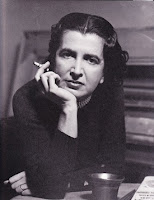by Marc Masurovsky
[This is the fourth in a series of articles on the fate of Jewish-owned collections confiscated by the ERR in France and their treatment at the Jeu de Paume/Louvre complex up to July 1943.]
Edouard Esmond was married to Valentine Deutsch de laMeurthe, closely linked to the Rothschild family. A British-born dandy and socialite living in Paris, Esmond was better known as a breeder of thoroughbred horses, and a golf enthusiast who founded the EsmondCup which he named after himself and his three daughters, also golf pros in their own right. As a matter of fact, Diane Esmond, one of his three daughters, won the Girls’ Golf Championship in 1926 at the age of 16!
The Esmonds lived at 54, avenue d’Iéna, in Paris, one of the most exclusive avenues on the right bank of Paris which feeds into the Place de l’Etoile where stands the “Arc de Triomphe.” Their immediate neighbor (52, avenue d’Iéna) was a colorful man by the name of Calouste Gulbenkian, Armenian-born oil tycoon and consummate art collector, who made his bed with the Germans in the early years of the German occupation of France before fleeing south due to his anglophile tendencies; he ended up in Portugal in late 1942 with the thousands of objects he collected that he was able to spirit out of German-occupied France.
Diane Esmond was born in 1910. Her passion, aside from golf,was art. While in Paris, she trained as a painter with Edouard MacAvoy and at the Académie de la Grande Chaumière. MacAvoy’s father was a banker and his mother descended from Huguenot nobility. Esmond developed a small following, worked closely with creative artists in the performing arts, and designed stage sets among other things. Pending further research, there are no indications that Esmond’s works were exhibited in galleries in Paris, either in group or solo shows.
 |
| Diane Esmond, n.d. dianeesmond.com |
In 1940, the Esmonds fled Paris like so many others. Edouard Esmond died in 1945 and Diane returned to France in 1952. She enjoyed a resurgence as an artist and exhibited in a number of well-known venues in Paris and New York through the 50s and 60s. She died in France in 1981.
| A page from the ESM inventory, Bundesarchiv, B323/270, Koblenz |
Let’s now try to divine the esthetic choices made by Dr. Tomforde.
The following works by Diane Esmond for which we have photographs were marked “vernichtet”. All of the photographs show the works on an easel, no effort being made to conceal the presence of the easel’s stand from the visual field:
ESM 5: Profile of a woman wearing a hat and a flower


ESM 6: A still life with grapes. The photo of this painting features the easel on which it was placed. 
ESM 19: A painter and his palette at work on a canvas. 
ESM 20: Portrait of a “negro child”. 
ESM 23: A woman wearing a white blouse. Painting on an easel.. 
ESM 26: A green landscape—perhaps leaning towards abstraction? The painting is on an easel. 
ESM 27: A cabaret scene. Painting on easel
The following seven paintings by Esmond were spared and for which we have photographs. These photos have been cropped to conceal the presence of the easel:
ESM 18: Full-length portrait of a naked woman seen from behind. 
ESM 24: A woman playing cards. 
ESM 25: A woman with a monkey—however we can’t see the monkey; she is seated inside a well-appointed but cluttered living room staring into space. 
ESM 28: A clown, seated on the ground, looking forlorn.



ESM 29: Men at a bar 
ESM 30: A scene at the ballet 
ESM 31: A clothed man viewed from behind.
What were the underlying Nazi cultural and esthetic standards that drove this apparently capricious selection? What explains the purge of Diane Esmond’s works?
Are we to assume that the selection [Selektion] which took place at the Jeu de Paume was an exercise in curatorial abuse? The only hint of Nazi ideology at work—in the form of racist tropes-could refer to ESM 5, ESM 20 and ESM 23, which portray individuals with “non-European” facial characteristics. In Nazi terms, they were not “Aryan.” However, it’s impossible to understand why a still life with grapes, a painting at work in his studio and a landscape could be assigned the “vernichtet” label while a scene of a woman playing cards, men at a bar, and a clown could be spared from destruction.
Your guess is as good as mine, but I would venture that the selection had little or nothing to do with Nazi cultural dogma, with the possible exception of the three works mentioned above.